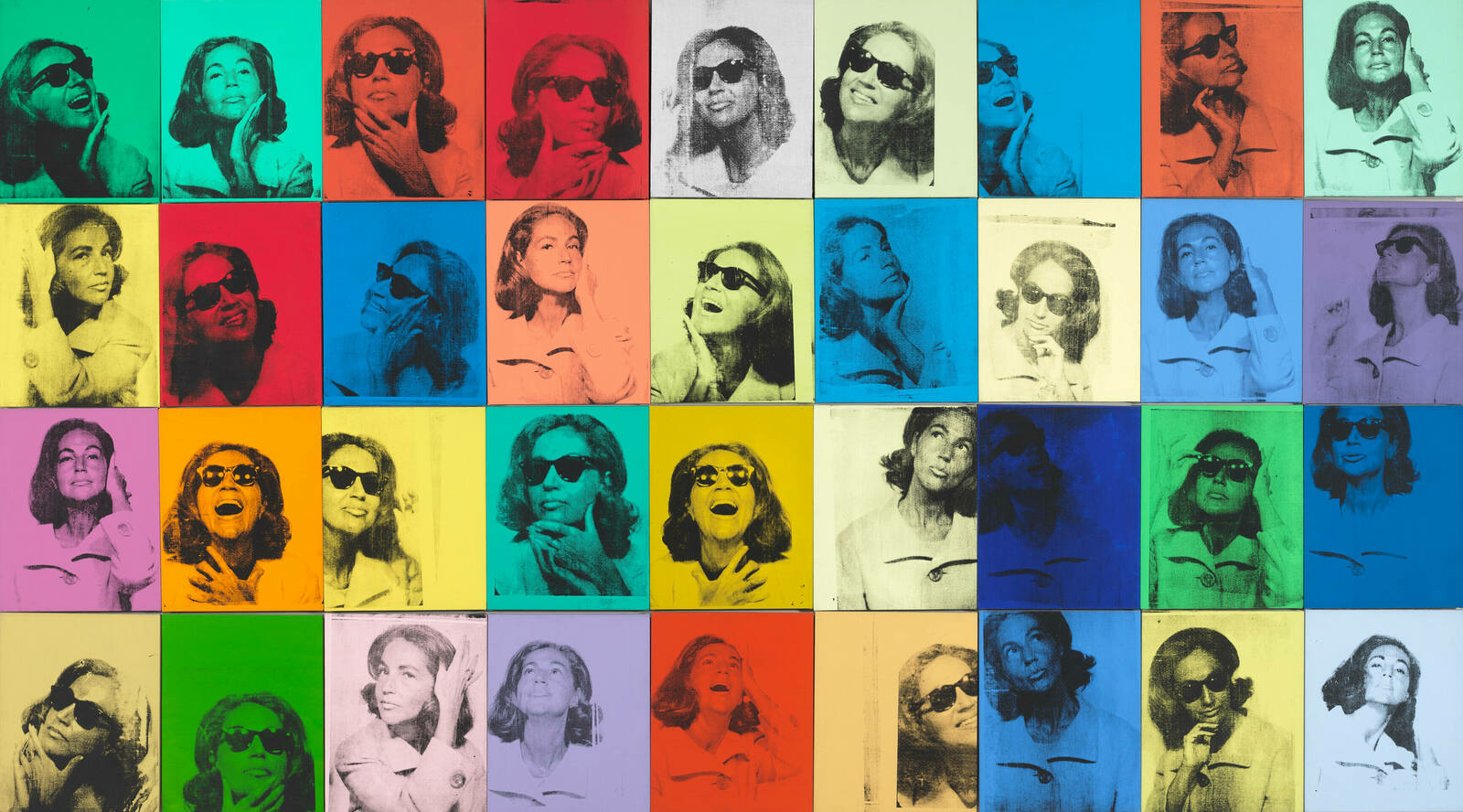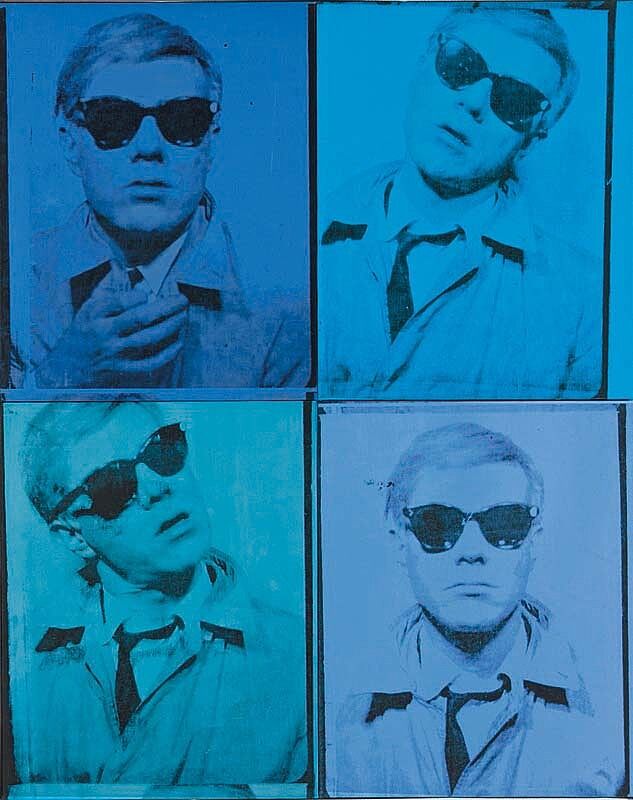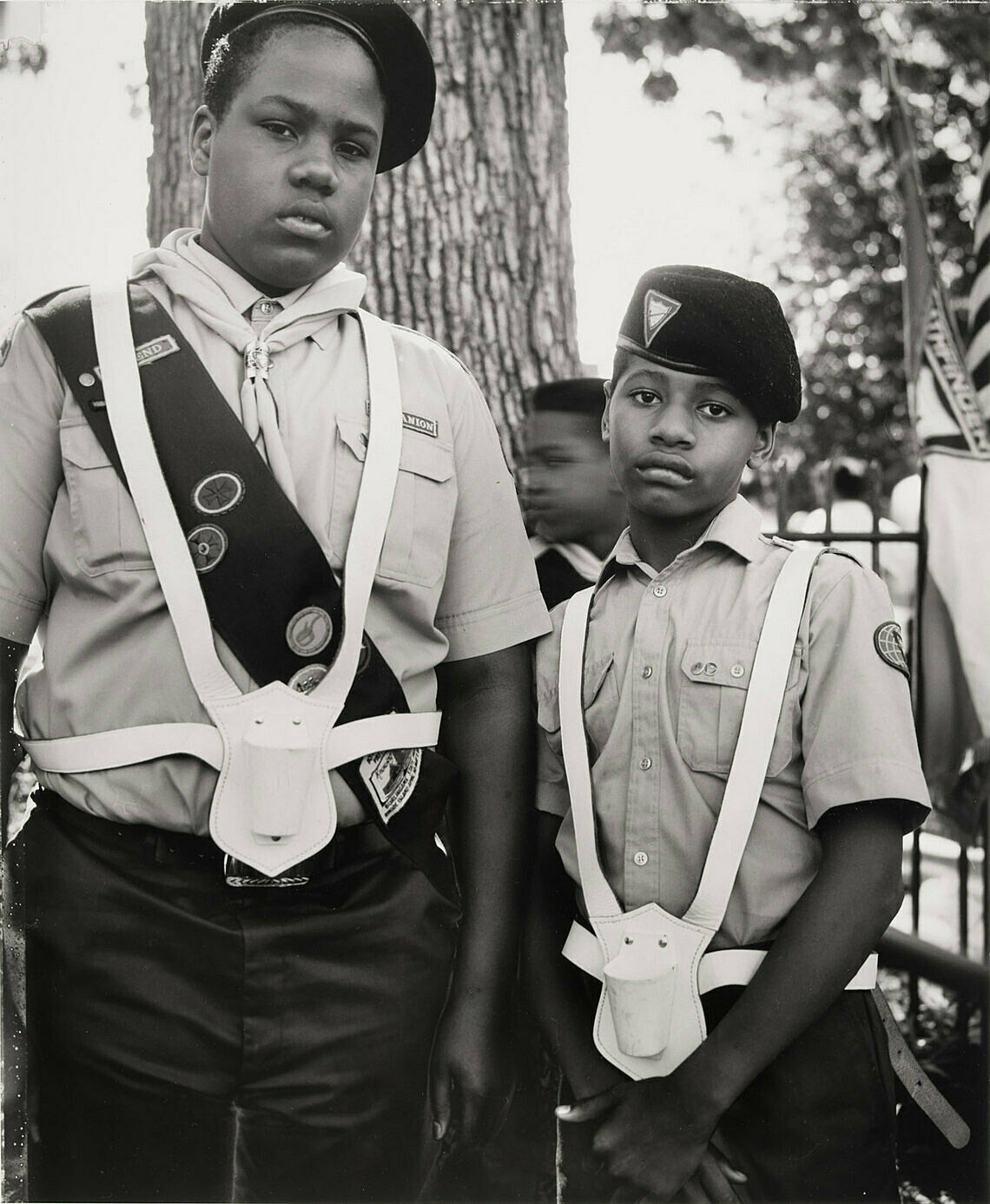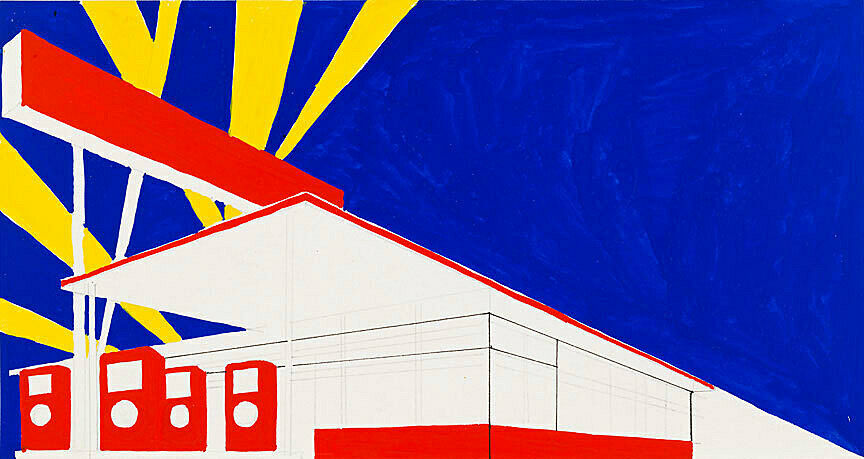Not on view
Date
1963
Classification
Paintings
Medium
Acrylic and screenprint on canvas, thirty-six parts
Dimensions
Overall: 80 × 144in. (203.2 × 365.8 cm) Overall (each): 20 × 15 7/8in. (50.8 × 40.3 cm)
Accession number
86.61a-jj
Credit line
Whitney Museum of American Art, New York; Jointly owned by the Whitney Museum of American Art and The Metropolitan Museum of Art; Gift of Ethel Redner Scull
Rights and reproductions
© The Andy Warhol Foundation for the Visual Arts, Inc. / Licensed by Artists Rights Society (ARS), New York
API
artworks/6131
Visual Description
Ethel Scull 36 Timeswas made in 1963, and was Warhol’s first commissioned portrait painting. This painting measures twelve feet wide by six and a half feet tall. It is composed of thirty-six individual screenprints, each one on a separate canvas that is twenty inches tall by sixteen inches wide. All of them are hung vertically, in four rows of nine screenprints each.
The subject of the piece, Ethel Scull, was a wealthy art collector, who eventually accumulated one of the largest collections of Pop art in the world. Each canvas is based a photograph of her, all in the same format and from the same distance. In fact, Warhol used a Times Square photobooth to shoot all of the pictures in rapid succession. Scull is glamorously styled, with soft, wavy hair, a large collar on her coat, and dark sunglasses. She poses in ways reminiscent of celebrity photo shoots—her head resting on the palm of her hand, one hand running through her hair, or her gazing out into the distance. In most of the photos, Ethel Scull is smiling or laughing; in others, she seems pensive and thoughtful; in still others, she is jokingly pouting or coyly looking into the camera. Because the photos are so clearly from the same photoshoot, it becomes obvious that all of these emotions were put on for the benefit of the artist. Rather than capturing a true moment, Warhol here is highlighting the artifice that goes into some photography, especially photography of celebrities.
Warhol painted each canvas a solid color before printing the images on it. All thirty-six canvases have their own unique color background, though some belong in the same color family. About a third of the canvases are painted in bright, deep reds, oranges, and yellows, colors one might experience in autumn leaves or ripe apples. Another third are painted with rich blues, greens, teals, and purples, colors reminiscent of ocean life. The final third are more muted, pale, and pastel versions of all the other colors, as might be used to paint Easter eggs. There is no discernible order to how Warhol placed these colors within his grid of canvases. They are all jumbled together, with warm colors next to cool or bright next to muted. Placed in this scattered way, they create a spectacular display of color.
Videos
Audio
-
Ethel Scull 36 Times, 1963
From Andy Warhol—From A to B and Back Again (Spanish)
0:00
Ethel Scull 36 Times, 1963
0:00
Narrator: Ethel Scull fue el primer retrato por encargo de Warhol. Ella esperaba que el artista realizara la pintura en su estudio. Pero cuando él pasó a recogerla por su departamento en la Quinta Avenida, los hechos siguieron otro camino.
Richard Meyer: La sube a un taxi y juntos van a Times Square; la lleva a un centro de juegos y la hace entrar a una cabina fotográfica donde se coloca una moneda de 25 centavos, eso costaba entonces, para sacar cuatro fotografías.
Narrator: Profesor Richard Meyer
Richard Meyer: Y él comienza a depositar monedas en la máquina, mientras le dice a Ethel Scull, "Ok, ya sabes, no te quedes ahí sentada, ¡posa! Haz algo, quítate las gafas de sol, desliza los dedos entre el cabello, sonríe", y comienza a dirigirla.
Continuó depositando monedas hasta obtener más de cien imágenes diferentes.
Uno siente que Ethel Scull se convierte en actriz dentro de la cabina fotográfica y que el personaje que encarna es una versión, o quizá múltiples versiones, de ella misma. Y, sí, es ella que aparece como una celebridad. Creo que eso era lo que querían todas las personas que no eran famosas y que le comisionaron retratos a Warhol en los años setenta. Querían la marca Warhol, aunque todavía no era una marca establecida. Sin embargo, eso es lo que ayudó a que se convirtiera en una marca, el deseo de esas personas de parecer famosas a través del estilo que Warhol usaba para pintarlas.
-
Audio description: Ethel Scull 36 Times, 1963
From Andy Warhol—From A to B and Back Again (Verbal description)
0:00
Audio description: Ethel Scull 36 Times, 1963
0:00
Narrator: Ethel Scull 36 Times was made in 1963, and was Warhol’s first commissioned portrait painting. This painting measures twelve feet wide by six and a half feet tall. It is composed of thirty-six individual screenprints, each one on a separate canvas that is twenty inches tall by sixteen inches wide. All of them are hung vertically, in four rows of nine screenprints each.
The subject of the piece, Ethel Scull, was a wealthy art collector, who eventually accumulated one of the largest collections of Pop art in the world. Each canvas is based a photograph of her, all in the same format and from the same distance. In fact, Warhol used a Times Square photobooth to shoot all of the pictures in rapid succession. Scull is glamorously styled, with soft, wavy hair, a large collar on her coat, and dark sunglasses. She poses in ways reminiscent of celebrity photo shoots—her head resting on the palm of her hand, one hand running through her hair, or her gazing out into the distance. In most of the photos, Ethel Scull is smiling or laughing; in others, she seems pensive and thoughtful; in still others, she is jokingly pouting or coyly looking into the camera. Because the photos are so clearly from the same photoshoot, it becomes obvious that all of these emotions were put on for the benefit of the artist. Rather than capturing a true moment, Warhol here is highlighting the artifice that goes into some photography, especially photography of celebrities.
Warhol painted each canvas a solid color before printing the images on it. All thirty-six canvases have their own unique color background, though some belong in the same color family. About a third of the canvases are painted in bright, deep reds, oranges, and yellows, colors one might experience in autumn leaves or ripe apples. Another third are painted with rich blues, greens, teals, and purples, colors reminiscent of ocean life. The final third are more muted, pale, and pastel versions of all the other colors, as might be used to paint Easter eggs. There is no discernible order to how Warhol placed these colors within his grid of canvases. They are all jumbled together, with warm colors next to cool or bright next to muted. Placed in this scattered way, they create a spectacular display of color.
-
0:00
Ethel Scull 36 Times, 1963
0:00
Narrator: Ethel Scull was Warhol’s first portrait commission. She had expected that he would make a painting of her in his studio. But when he picked her up from her Fifth Avenue apartment, that’s not how things went.
Richard Meyer: He puts her in the taxi cab, they go down to Times Square, he took her into an arcade, and he put her in a photo booth machine where you put—at that point it was four for a quarter.
Narrator: Professor Richard Meyer.
Richard Meyer: So he started feeding quarters into the machine and saying to Ethel Scull, "Don't just sit there! Do something, take your sunglasses off, put your fingers through your hair, smile" and he just started basically directing her.
He kept feeding quarters into it until they had over 100 different images.
You get the sense that Ethel Scull, in this photo booth machine, becomes an actress, and the character she's embodying is a version—or maybe multiple versions—of herself. And yes, it is herself as a celebrity. And that's, I think, what all those people who commissioned portraits of Warhol in the seventies who weren't famous wanted. They wanted the Warhol brand. It wasn't yet a brand here. Yet, this is what helped it become a brand, but they wanted to look famous through Warhol's style of painting them.



